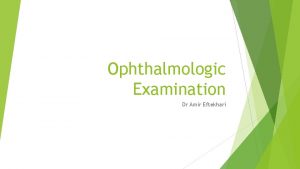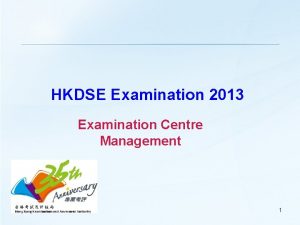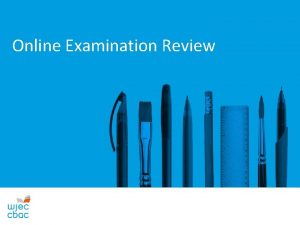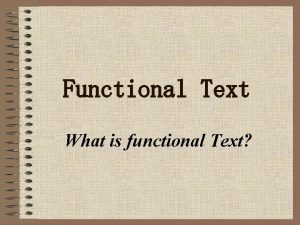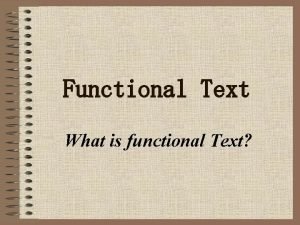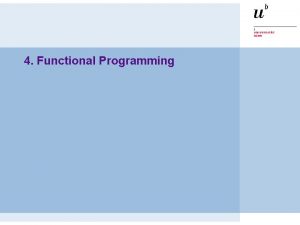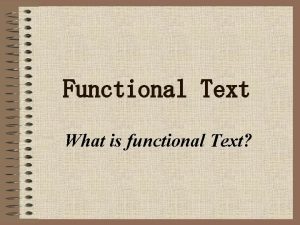1 Ophthalmologic Examination Integrated With The Functional Aspects




























- Slides: 28

1 Ophthalmologic Examination Integrated With The Functional Aspects of CVI Sharon S Lehman, MD FAAP Chief Ophthalmology Nemours Children’s Clinical Professor of Ophthalmology and Pediatrics Robison D Harley MD Endowed Chair of Pediatric Ophthalmology

2 2 12 month ex 23 -week premature infant with tracheostomy, h/o retinopathy of prematurity who has been recently diagnosed with cerebral palsy. Child’s mother is concerned that child looks past her, stares at lights and looks away when reaching for an object.

3 3 OPHTHALMOLOGIST REPORT: IMPRESSION: ROP RESOLVED; NORMAL EYE EXAM RECOMMENDATIONS: F/U 1 YEAR

What my exam should include… n Obtain history focused on child’s visual behavior/characteristics n Validate parent’s observations n Learn patient’s expectations for their child n Perform complete ophthalmologic examination n Provide medical diagnosis and medical necessity n Refer for services for visually impaired n Make specific recommendations tailored to individual patient n Provide information to patient’s team n Provide educational materials/support group information n Provide opportunity for parent’s to ask questions 4 4

Classic Ophthalmologic Exam – Exam #1 Focus: History and Structure n History with CVI modified questionnaire n Physical-Classic Ophthalmologic Exam n Visual acuity n Pupillary reaction n External n Anterior and posterior segment n Alignment and motility n Cycloplegic refraction 5 5

CVI Ophthalmologic Exam #2 Focus: Function n Classic Ophthalmologic Exam #1 n History with CVI modified questionnaire n Structural Physical exam + n Physical n Accommodative amplitude/dynamic retinoscopy n Convergence amplitude/NPC n Visual attention/fixation/visually guided behavior n Latency n Saccades/pursuits n Directionality of line n Contrast Sensitivity 6 6

CVI Ophthalmologic Exam #3 Focus: Higher Level Function n Classic Ophthalmologic Exam #1 + n CVI Ophthalmologic Exam #2 + n Physical n Executive functions n Figure ground skills n Comparison of size and shape n Visual center 7 7

8 CVI Type 1 Exam (History and Structure) CVI Type 2 3 Exam (Higher Exam (Function) Level Function) Low function Phase 1 High function Phase 2 Phase 3

What my exam is not… n It is NOT a substitute for evaluation by Teacher of Visually Impaired n It is NOT a substitute for evaluation by Occupational Therapist n It is NOT a substitute for evaluation by Physical Therapist n It is NOT a substitute for evaluation by Learning/Reading Specialist 9 9

HISTORY n“Please tell me about your child’s vision”. n There is no better expert than a child’s parent. n They will often tell you most of you need to know. 10 10

CVI Modified Questionnaire Preference for specific colors: Improved visual response with movement: Latency (delay in response to visual stimuli Abnormal field of vision (eg: hemianopsia or island of visual response) Difficulty with visual complexity: Preference for looking at lights and non purposeful gaze Difficulty with distance viewing Atypical visual behavior (eg: frequently looking up or away while tracking, eccentric viewing) Difficulty with visual novelty Absent or clumsy visually guided motor responses Adapted from: Roman-Lantzy, Christine; Cortical Visual Impairment: an approach to assessment and intervention; American Foundation for the Blind; New York, New York; 2007 M 11 11

Multidisciplinary team approach Parents/family Primary care physician Pediatric ophthalmologist Pediatric neurologist Educational specialist Teacher of visually impaired Teacher of the hearing impaired Occupational therapist Physical therapist Speech therapist Feeding specialist 12 12

EXAM #1 n n History with CVI modified questionnaire and basic ophthalmologic exam n r/o structural eye abnormalities/confounding factors n Determine any necessary optical correction n Determine any necessary medical or surgical ophthalmologic treatment Child with limited visual response who is learning to use vision 13 13

EXAM #2 n History and Modified CVI Questionnaire and Exam #1 n Additional aspects of exam n n n n Accommodative amplitude/dynamic retinoscopy Convergence amplitude/NPC Visual attention/fixation/visually guided behavior Latency Saccades/pursuits Directionality of line Contrast Sensitivity Child with higher visual function learning to use vision more effectively along with other functions of daily life 14 14

15 15 EXAM #3 n History and Modified CVI Questionnaire and Exam #1 + Exam #2 + Physical n n Executive functions n Figure ground skills n Comparison of size and shape n Visual center CVI characteristics improved or resolving with higher level visual function deficits (Cerebral? )

16 CVI Type 1 Exam (History and Structure) CVI Type 2 3 Exam (Higher Exam (Function) Level Function) Low function Phase 1 High function Phase 2 Phase 3

What my exam should include… n Obtain history focused on child’s visual behavior/characteristics n Validate parent’s observations n Learn patient’s expectations for their child n Perform complete ophthalmologic examination n Provide medical diagnosis and medical necessity n Refer for services for visually impaired n Make specific recommendations tailored to individual patient n Provide information to patient’s team n Provide educational materials/support group information n Provide opportunity for parent’s to ask questions 17 17

18 18 12 month ex 23 -week premature infant with tracheostomy, h/o retinopathy of prematurity who has been recently diagnosed with cerebral palsy. Child’s mother is concerned that child looks past her, stares at lights and looks away when reaching for an object.

19 19 OPHTHALMOLOGIST REPORT: IMPRESSION: ROP RESOLVED; NORMAL EYE EXAM RECOMMENDATIONS: F/U 1 YEAR

Ophthalmologist’s Report Impression/Diagnosis IMPRESSION: n Cortical visual impairment n Severe visual impairment both eyes n Retinopathy of prematurity Stage 2 Zone II both eyes – resolved n Cerebral palsy n Premature infant n Hypermetropia both eyes not requiring correction 20 20

Ophthalmologist’s Report Recommendations n Treat underlying medical conditions. n No glasses are necessary n Recommendations: n n n n Use high contrast and brightly colored visual materials. Use additional cues (lights, sound, vibration and movement) to attract visual attention. Avoid overstimulation. Provide support for child’s body when performing visual tasks. Avoid verbal distractions when child is performing visual tasks. Perform visual tasks in non-distracting environment. Refer for evaluation for services for vision. 21 21

Ophthalmologist’s Report Recommendations n Copy of diagnosis, medical necessity and recommendations sent to patient’s team n Educational material and support group information given to family n Family’s questions answered, they expressed understanding and agree with plan n Include contact information so other members of child’s team can share information. 22 22

23 23 PEDIATRIC OPHTHALMOLOGISTS: Would you like to learn more about CVI? GOOD NEWS! Reference: Lehman SS, Attitudes Concerning Cortical Visual Impairment Among Pediatric Ophthalmologists and Teachers of the Visually Impaired¿ presented at 2016 American Conference on Pediatric Cortical Visual Impairment, Omaha, Nebraska, July 8 -9, 2016

Modalities to Assist Pediatric Ophthalmologists with CVI n Providing education and templates for: n History n Physical examination n Providing diagnosis n Referral for services n Making recommendations/interventions 24 24

TEMPLATES FOR RECOMMENDATIONS/INTERVENTIONS n Should not be cookie cutter. n Need to be specific to each child’s circumstances n Need to be incorporated into child’s activities of daily living n Need to include environmental modifications n Need to include developmentally appropriate recreation (play) for older children 25 25

TEMPLATES FOR CVI INTERVENTIONS/RECOMMENDATIONS FOR PEDIATRIC OPHTHALMOLOGISTS Characteristi c Preference for specific color Interventions for child with limited function (lower phase) Interventions for child with better function (higher phase) Exploit color preference in choice of visual objects of regard. Use objects of preferred color for ADL. Have teacher, instructor, or therapist wear preferred color in order to maintain interest and localization for following (e. g. : learning to drive motorized chair). 26 26

TEMPLATES FOR CVI INTERVENTIONS/RECOMMENDATIONS FOR PEDIATRIC OPHTHALMOLOGISTS c Interventions for Characteristi child with limited function (lower phase) Latency Provide extra time for localization and following of visual stimuli. Interventions for child with better function (higher phase) Gradually work toward decreasing time needed for localization and following. Provide extra time for completion for educational tasks. 27 27

28 28 n I need your feedback about improving the pediatric ophthalmologist’s care of children with CVI Please email me at: slehman@nemours. org
 Enzymes in plasma
Enzymes in plasma Functional and non functional
Functional and non functional Transpalatal arch space maintainer
Transpalatal arch space maintainer Non functional plasma enzyme
Non functional plasma enzyme Sự nuôi và dạy con của hươu
Sự nuôi và dạy con của hươu Thế nào là hệ số cao nhất
Thế nào là hệ số cao nhất Diễn thế sinh thái là
Diễn thế sinh thái là Ng-html
Ng-html Vẽ hình chiếu vuông góc của vật thể sau
Vẽ hình chiếu vuông góc của vật thể sau Phép trừ bù
Phép trừ bù Lời thề hippocrates
Lời thề hippocrates Vẽ hình chiếu đứng bằng cạnh của vật thể
Vẽ hình chiếu đứng bằng cạnh của vật thể Chụp tư thế worms-breton
Chụp tư thế worms-breton đại từ thay thế
đại từ thay thế Quá trình desamine hóa có thể tạo ra
Quá trình desamine hóa có thể tạo ra Sự nuôi và dạy con của hổ
Sự nuôi và dạy con của hổ Thế nào là mạng điện lắp đặt kiểu nổi
Thế nào là mạng điện lắp đặt kiểu nổi Các châu lục và đại dương trên thế giới
Các châu lục và đại dương trên thế giới Dot
Dot Bổ thể
Bổ thể Thế nào là sự mỏi cơ
Thế nào là sự mỏi cơ Phản ứng thế ankan
Phản ứng thế ankan Thiếu nhi thế giới liên hoan
Thiếu nhi thế giới liên hoan Phối cảnh
Phối cảnh Chúa sống lại
Chúa sống lại điện thế nghỉ
điện thế nghỉ Một số thể thơ truyền thống
Một số thể thơ truyền thống Trời xanh đây là của chúng ta thể thơ
Trời xanh đây là của chúng ta thể thơ Sơ đồ cơ thể người
Sơ đồ cơ thể người





























